More about: Marrakech in two days: what you need to know to make sure you don't miss a thing
A two-day stay in Marrakech, although short, will allow you to cover much of what there is to see and do in Marrakech and even some of the places just outside the city. The city has a population of over 1.5 million and is one of Morocco's Imperial Cities, along with Fez, Meknes and Rabat.
To make the most of these two days, you'll need to plan your time well. This is the only way to lose yourself in the labyrinth of streets that make up the Medina to see its mosques and souks, visit the Palm Grove and experience the atmosphere of the Jamaa el Fna square up close.
Day 1: From the Medina to Jamaa el Fna Square

One of the best ways to adapt to the city is to take your first visit with a guided tour. The routes of many of these guided tours are similar to the itinerary I have prepared for the first day.
In particular, the plan for this first day includes highlights such as the souk and the Medina, without forgetting the Jamaa el Fna Square in its day and night versions.
Enter the kashbah through the ancient Bab Agnaou gate
To make the most of your time in Marrakesh, whether you do the tour on your own or with a guide, the day should start early in the morning.
Although the nearby Bab er Robb was the official entrance to the city, we will begin our tour at Bab Agnaou. As its name indicates ("bab" means gate in Arabic), it was one of the 19 entrances in the city walls that led to the interior of the town.
Bab Agnaou is the gate that leads to the ** kashbah**, a type of fortified building of Berber origin that eventually served as a residence for a powerful family. In this case, it is the royal kashbah. The entrance, built in the 12th century, is single-coloured with a central archway leading to the El Badi Palace and the Sa'did tombs.
The Sa'did tombs and their impressive hall
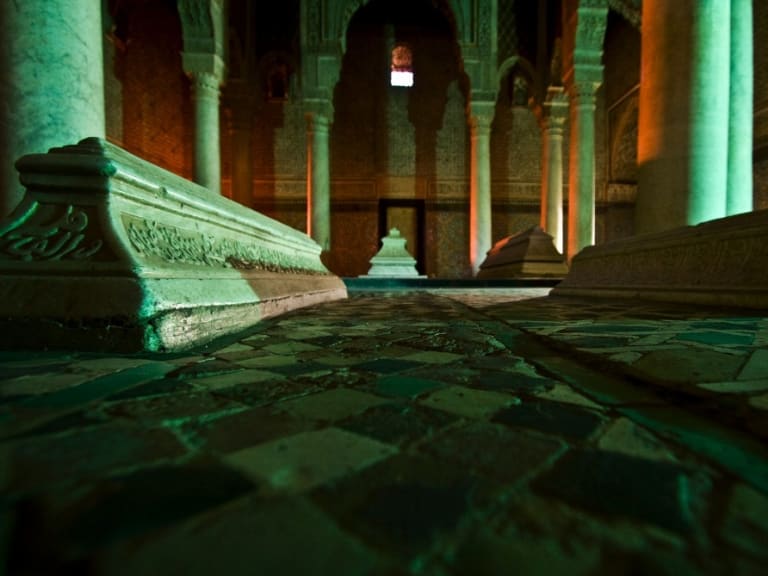
The next point on the route is a straightforward walk to a green-tiled minaret located a few metres from Bab Agnaou. The minaret in question is part of the Moulay El Yaziz Mosque, next to which are the Saadid tombs, one of the most interesting sights in all of Marrakesh.
These tombs date from the end of the 16th century, when Sultan Al Mansur ordered them to be built. However, a few decades later they were walled up by order of another sultan, Mulay Isma'il, and were completely forgotten. It was not until 1917 that they were rediscovered.
Access to the tombs, which can be visited for an entrance fee, is through a narrow passageway leading to a small garden. The burials of various servants, chancellors and warriors are located in the garden. Around this courtyard are located a number of buildings containing the tombs of more important personages. The tomb of Sultan al-Mansur himself is located in the so-called Hall of the 12 Columns, undoubtedly the most impressive room in the complex.
Bay Palace
On the way to the next destination, wandering around the medina trying not to get too lost if you have decided to go on your own, it is interesting to stop at the Place des Ferblantier (also included in many private tours). In addition to the beauty of the square itself, you will find a large number of shops specialising in products made of tin and other metals.
After a look around the square and the aforementioned shops, the tour continues to one of the most popular sights for visitors: the Bahia Palace.
At the time of its construction in the 19th century, the intention was to build the largest palace in the world. Although that wish was not fulfilled, the gardens and the harem inside are two of the city's great attractions.
Jamaa el Fna Square
If there is one place that defines the ochre-smelling city, it is Jamaa el Fna Square. When you get there you will find a large number of fruit juice sellers and henna tattoo artists. Alongside them are street performers such as the typical snake charmers and monkey tamers, not forgetting the storytellers.
The atmosphere, the smells and the sights will hit you from all sides. You may well feel like photographing almost everything you see, but it is very important that you do not do so without asking permission and negotiating a price for the photo beforehand.
Get your strength back at Dar Cherifa
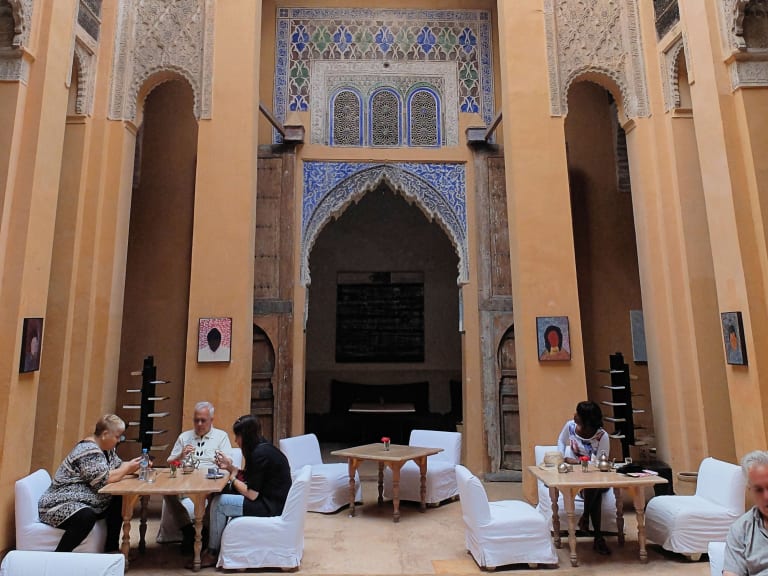
One of the most popular organised tours in Marrakech is the one dedicated to gastronomy. If, due to lack of time, you haven't booked it, a visit to Dar Cherifa will be a perfect introduction to Moroccan food.
This restaurant is not only one of the best restaurants serving tajine or couscous, but the building in which it is located is certainly spectacular. It is one of the most beautiful riads (traditional houses) in the city.
Take a leisurely stroll through the souk and learn how to haggle.
Once you have recovered your strength, you can still enjoy one of the most intense experiences in Marrakesh: the souk. You can also book one of the guided tours specifically for these markets.
This large market occupies many narrow streets in the Medina. The large number of people makes it difficult to move around comfortably, especially if you have to share the space with many stalls located in the same streets. In order to enjoy this walk , I advise you to always keep calm. Also, try to avoid vendors who try to attract your attention in a more aggressive way and false guides.
The best way to do this tour is not to try to know where you are at all times. Just wander around the streets and look for the products you like the most. You'll find everything from babouches to tea sets, spices, carpets, silk garments, cosmetics, metal lanterns and djellabas. Remember, however, that it is customary to haggle with the seller until you reach an agreement, or not. Each person will have an area that most appeals to him or her. My choice is Rahba Kedima Square, where medicinal herbs and basketry are sold.
Marrakesh Museum and Almoravid Qoubba
As you walk through the souk, try to find an ancient Muslim school called Medersa Ben Youssef. Go inside to see its impressive central courtyard and the decoration of the arches and doors.
Nearby is the Marrakesh Museum. You should at least peek into its inner courtyard, as its beauty makes it one of the most recommended visits.
Right next to it is the Almoravid Quobba, the last example of this style to be found in the city, which you can also see if you go on an excursion to Essaouira. Today, the building contains a souk called Souk Foudouq Ouarzazi which is well worth a few minutes of your time.
Koutoubia Mosque
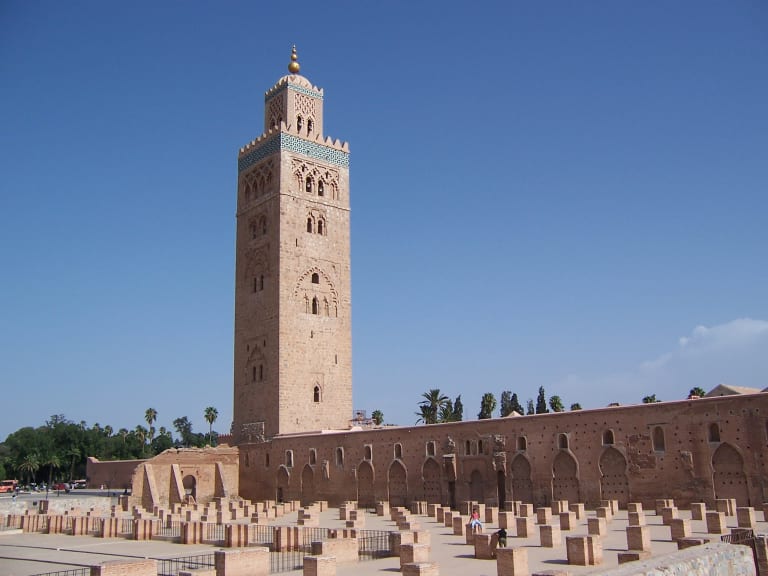
This first tour requires you to continue walking through the Medina of Marrakech to see one of its most famous buildings. This time, the destination is the Koutoubia Mosque, the most important mosque in Marrakech.
Although this 1158 mosque cannot be visited inside, only its exterior decoration and the fabulous 70-metre-high minaret make it a must-see. The minaret is very similar to the Giralda in Seville and is still the highest point in the city.
A sundowner and mint tea on the terrace of Café Glacier
After an intense day, the reward should be just as impressive. For this, nothing better than to go to Café Glacier to enjoy a delicious mint tea on its terrace.
As well as relaxing with your tea, from there you can watch the sunset and the neighbouring Jamaa el Fna square transforming to face the hours ahead.
Back to Jamaa el Fna Square
Dusk almost completely changes the look and feel of the square. The vendors who once occupied the square are gone and their place is taken by many food stalls competing with each other to attract visitors.
This is certainly the perfect setting for a bite to eat before retiring to your hotel. Stroll around the various stalls and choose the one that suits you best, without paying too much attention to the calls of the various vendors trying to get you to sit at their tables.
Joaquin's Traveller Tip
There is a lot of competition between the various food stalls and sometimes a waiter can be a little too pushy. Keep calm and sit in the place that interests you the most, despite the calls of others.
Day 2: See the Palm Grove and other lesser-known attractions in Marrakech

Walking through the Medina and the Jamaa el Fna are truly magnificent experiences, but also exhausting. For this reason, the second day in Marrakech will be a little more relaxed. Although the places to visit are a little less famous, I assure you that they have nothing to envy to those of the first day.
Take a short trip to the Palm Grove
The first place to head to on your second day in Marrakech is Marrakech's Palm Grove area, about 10 kilometres from the Medina. The options for getting there are varied. On the one hand, you can always go by taxi after negotiating a fare with the driver that includes a waiting time. You can also go by horse-drawn carriage, one of the most traditional ways of getting around Marrakesh.
Finally, there are numerous tours that take you to the area. Practically every visitor will find one to suit his or her taste, from one that uses quads and allows you to visit some of the villages to one that includes a camel ride. In the latter case, there is also a tour that offers a sunset in the Palm Grove and a camel ride. If you are interested in this possibility, just change the order of the itinerary.
The Palm Grove has traditionally been a great source of income for the city. Although this has not changed, today it has become one of the city's main tourist attractions and is part of a development plan that foresees the opening of several hotels. Despite this, the place still retains a mystical air and nature is still predominant. This is made possible by more than 100,000 palm trees, fruit trees and plantations.
Majorelle Gardens
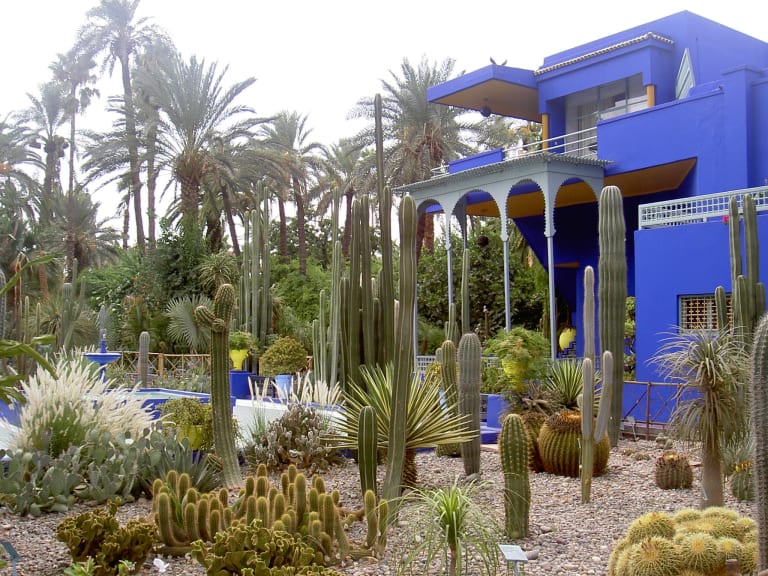
Depending on how much time you have spent in the Palm Grove it may be possible to visit these spectacular gardens.
A taxi from the Palm Grove itself or from the Jamaa el Fna will get you there with no problem. The gardens were created by a French painter, Jacques Majorelle, in 1924 and are undoubtedly the most beautiful in the city.
Despite the climate of Marrakesh, the gardens are home to numerous varieties of aquatic plants. Alongside them are various types of jasmine, cactus, banana trees, palm trees and bamboo. An oasis of freshness in a city surrounded by desert.
See another side of Marrakesh: the modern city of Gueliz
Marrakesh, like all Moroccan cities, is not just about the old Medina. During the French protectorate, Gueliz, the modern part of the city, was built. The centre of this area is Place 16 November, where the central market is located.
This square is the origin of several avenues, including Mohammed VI Avenue. If you walk along it, you will see that the atmosphere is totally different from that of the old part, although it is just as crowded.
This area is also perfect for a bite to eat. Here you'll find some more Western-style restaurants and some Moroccan restaurants. If you have a sweet tooth, I recommend you try the Arabic sweets at Patisserie Amandine.
Mellah: the Jewish quarter
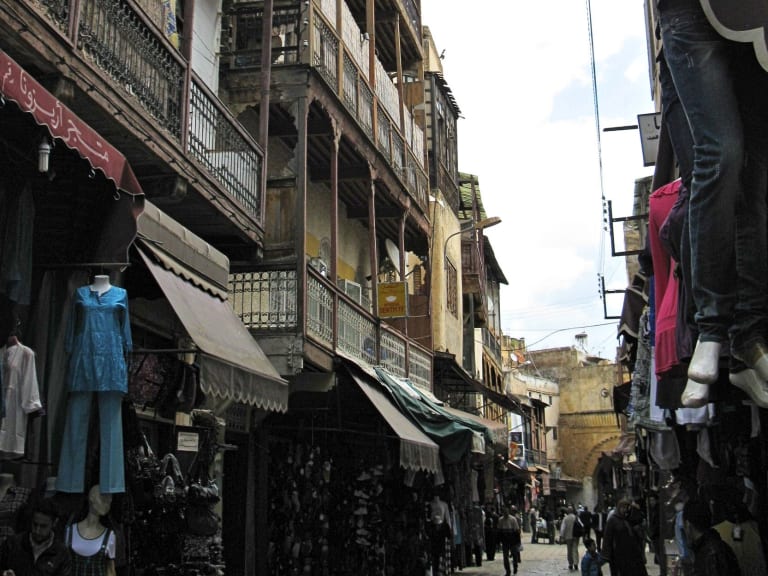
Another lesser-known but very interesting neighbourhood is Mellah, the former home of Marrakesh's Jewish community. It is one of the things to do and see in Marrakesh. The neighbourhood appeared in the 16th century, when the Spanish and Portuguese Jews were expelled from both countries and many of them settled in neighbouring Morocco.
Although the Jewish community has almost disappeared, the neighbourhood still retains an essence that sets it apart from other parts of the city. If you can, as well as strolling through its streets (some of which you already visited on the first day), come and visit the Al Azama Synagogue and the Jewish Cemetery.
The Mellah is also an ideal place to buy some gifts. In its streets you'll find plenty of shops and markets, with fewer people than in the Souk and at cheaper prices.
Relax in a hammam
One of the symbols of the Arab world are the hammams, and Morocco is no exception. In Marrakech you will find a number of these high-quality traditional baths where you can enjoy a good bath and massage.
When choosing one you should know that you will find some that are not mixed and require you to bring bath products. More comfortable are those designed for tourists which, although somewhat more expensive, are mixed and include everything you need to enjoy the experience.
The most recommended are Click Spa and Rosa Bonheur, but your hotel can recommend a few more so you can choose the one you like best.
Dinner at Comptoir Darna
Some of the organised tours end with a dinner that includes some of the best-known Moroccan dishes. If you prefer another option, Marrakech offers great possibilities to end your trip in style.
A great way to end your trip is, for example, to dine at one of the trendiest places in town, Comptoir Darna. In addition to the quality of the food, they often offer a belly dancing show that is far from those designed specifically for tourists.
Tips for your trip to Marrakech
In order for you to make the most of your trip to Marrakech, here are a few tips:
- Despite its geographical and historical proximity, many travellers still have some misgivings about visiting Morocco. Although I personally have never encountered any problems, it is always a good idea to consult some safety tips before you start your trip.
- It is important that before your trip, you are up to date on how to get around Marrakech.
- Check out my express guide to visiting Marrakech in one day to see all the must-see sights.
- Calculate your daylight hours carefully, as they vary greatly depending on whether you opt for winter in Marrakesh or summer in Marrakesh.



